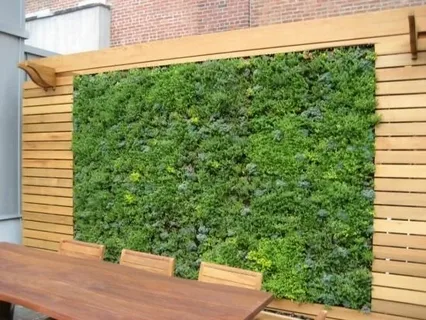Vertical Gardening: A Space-Saving Solution for Small Yards
If you have a small yard or limited space for gardening, vertical gardening could be the perfect solution. By growing plants vertically, you can maximize your available space, add beauty to your environment, and create a lush garden without taking up much room. Whether you have a balcony, small backyard, or even an indoor space, vertical gardening offers numerous benefits and is easier than you might think.
1. What is Vertical Gardening?
Vertical gardening is the practice of growing plants upward instead of outward, utilizing structures like walls, fences, trellises, and shelves to support plants. It’s an innovative way to grow a variety of plants, including vegetables, herbs, flowers, and climbing plants.
2. Why Choose Vertical Gardening?

Space-Saving
Vertical gardening is an excellent solution for those with limited garden space. By growing plants upwards, you can free up valuable ground space for other uses, such as lounging or additional landscaping.
Increased Yields
When plants grow vertically, they can take advantage of more sunlight, improving the overall yield. This is especially beneficial for fruits and vegetables.
Aesthetic Appeal
Vertical gardens can add beauty and texture to your home or garden. From cascading vines to colorful flowers, these gardens create stunning focal points.
Easy to Maintain
Vertical gardens are easier to maintain than traditional ones because they are typically higher off the ground, making weeding, watering, and harvesting simpler.
3. Types of Vertical Gardens
There are many ways to create a vertical garden. Here are a few popular methods:
1. Trellises and Arbors
Trellises and arbors are classic vertical gardening solutions, ideal for climbing plants like tomatoes, cucumbers, peas, and beans.
2. Vertical Planters
These are multi-layered planters that stack or hang, allowing you to grow plants in compact spaces. They work well for herbs, strawberries, or flowers.
3. Hanging Baskets and Containers
You can hang baskets or containers from ceilings, fences, or walls to grow trailing plants, flowers, or small vegetables.
4. Vertical Raised Beds
A vertical raised bed allows you to grow plants upwards with the help of a structure like a wooden frame or mesh. You can grow leafy greens, small root vegetables, and herbs in these beds.
5. Vertical Gardens on Walls
You can also create living walls using mesh, felt pockets, or hydroponic systems to grow a variety of plants. These are great for flowers, herbs, and even vegetables.
4. Tips for Successful Vertical Gardening
1. Choose the Right Plants
Not all plants are suitable for vertical gardening. Choose plants that grow well vertically or are suited for smaller spaces, such as:
- Climbers and Vines: Beans, cucumbers, peas, morning glories, and roses.
- Compact Plants: Lettuce, spinach, strawberries, and herbs like basil and thyme.
- Flowers: Petunias, pansies, and begonias.
2. Use Quality Support Structures
Ensure that the structures you use to support your vertical garden are sturdy enough to hold the weight of plants as they grow. Wooden trellises, metal frames, or plastic mesh are ideal for supporting vines and climbing plants.
3. Ensure Proper Sunlight
Like traditional gardens, vertical gardens need adequate sunlight. Place your vertical garden in a location that receives at least 6 hours of direct sunlight per day, especially for vegetables.
4. Watering Techniques
Vertical gardens may dry out faster than traditional gardens, so ensure consistent watering. Use drip irrigation or a soaker hose to provide efficient watering. Consider using a self-watering planter system to reduce the frequency of watering.
5. Pruning and Training Plants
Keep your plants in check by regularly pruning and training them to grow along your vertical supports. This ensures the plants stay healthy and don’t become unruly or overcrowded.
5. Vertical Gardening Ideas for Small Yards

1. Vertical Herb Garden
Create a small vertical herb garden by installing a wooden frame with pockets to hold potted herbs. This setup works well on patios, balconies, or even kitchen walls.
2. Vertical Vegetable Garden
Grow your own food even in the smallest spaces by planting vegetables like tomatoes, peppers, and zucchini on a vertical trellis or in stacked planters.
3. Living Wall
Transform a bare wall into a living masterpiece by installing a vertical garden system using felt pockets or metal grids. You can plant a variety of flowers, herbs, or succulents for a lush green wall.
4. Ladder-Style Vertical Garden
Upcycle an old ladder and turn it into a vertical garden by adding shelves or planters on each step. This works well for smaller plants like flowers, succulents, or herbs.
5. Balcony Vertical Garden
Make the most of your balcony space by hanging planters or creating a vertical garden along the railing. You can plant flowers, herbs, or even small vegetables in these containers.
6. Final Thoughts
Vertical gardening offers a creative, efficient way to grow plants in small spaces. Whether you’re looking to add greenery to your balcony, patio, or even your kitchen, vertical gardening can help you create a beautiful, productive garden in the most compact areas. By selecting the right plants, utilizing sturdy structures, and ensuring proper care, you can enjoy a flourishing vertical garden year-round.
